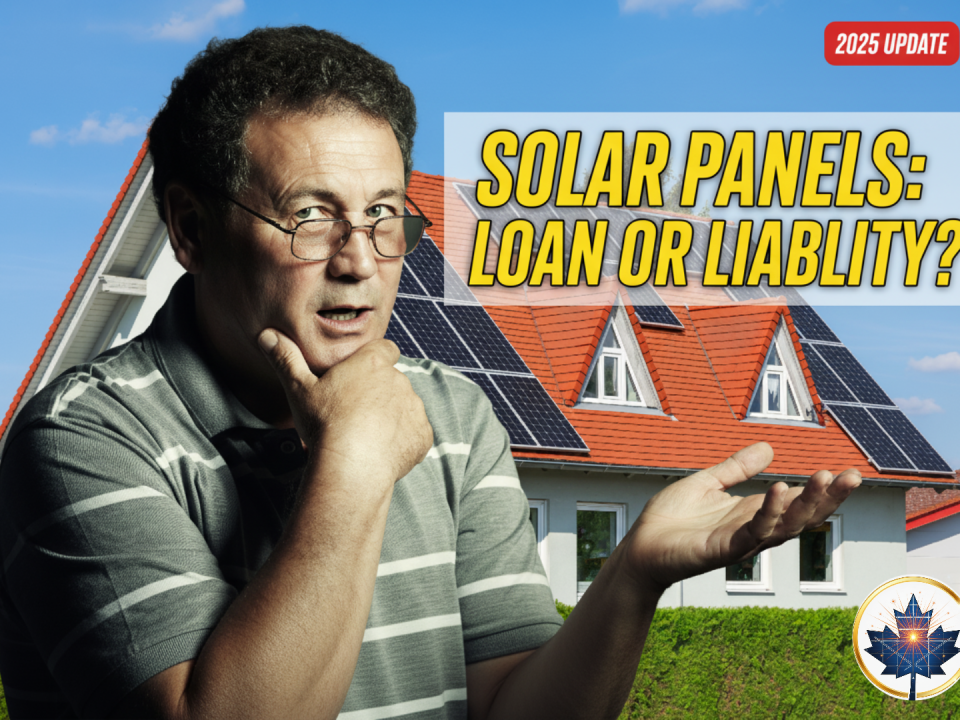
Upcoming Solar Panel Rebates & Incentives In Quebec 2025
September 1, 2025
P.E.I. Closes Solar Rebate Program: What’s Next?
September 6, 2025Today, we’re tackling a big topic: solar panels on Canadian farmland. Is it a golden opportunity or a headache waiting to happen? Let’s get into the real numbers and stories from the field.

Why Are We Even Talking About Solar on Farms?
Let’s cut to the chase. Farming is tough. Margins can be thin, and energy costs are a constant pressure. A dairy farm, for example, has coolers, milking machines, and ventilation systems running around the clock. The electricity bill can be staggering. This is where solar energy enters the picture, not just as a green idea, but as a serious business decision for Canadian farmers.
How Solar Farms and Farmland Can Coexist With Real Examples
Slashing Your Biggest Overhead: Energy Costs
The most immediate win for any farm that installs solar panels is a dramatic drop in energy costs. Think about it. Your farm operations rely heavily on electricity. By generating your own power, you reduce what you pull from the grid.
Statistics Canada data shows that farm electricity expenses have been on a steady rise. For many, this isn’t a small line item; it’s a major financial drain. A typical solar installation can offset 50% to 90% of a farm’s energy needs. I’ve seen farmers go from paying thousands a month to just paying basic connection fees. That’s real money that goes right back into your pocket or into improving your farm.

A New “Cash Crop”: Selling Power to the Grid
Beyond just saving money, solar panels can make you money. When your solar energy system produces more electricity than your farm operations need, that excess energy can be sold back to the local grid. This creates a new, reliable revenue stream.
How much are we talking? It depends on your province’s programs and the size of your solar installation. In provinces with supportive net-metering or feed-in tariff programs, this can become a significant part of a farm’s income. It’s like having a crop that you don’t have to plant or water; it just harvests sunlight.
Tip for Farmers: Before you sign anything, get a clear projection of energy production for your specific location. Look at historical weather data, not just sunny-day estimates. A good solar company will provide this.

Agrivoltaics: The Game-Changer for Farmland
Okay, so putting solar panels on a field sounds like you’re taking away valuable land for food production, right? This is a huge concern, and it’s valid. But this is where a concept called “agrivoltaics” comes in.
What Exactly is Agrivoltaics?
Agrivoltaics is the practice of combining solar energy production with agricultural activities on the same piece of land. Instead of covering a field completely, solar arrays are raised higher off the ground and spaced further apart. This allows for sunlight to reach the ground, meaning you can still grow crops or graze animals underneath the solar panels.
This isn’t just a theory; it’s working right now. Research from various agricultural institutes has shown some pretty amazing results:
- Improved Crop Yields: For certain crops that thrive in partial shade (like lettuce, kale, and potatoes), the shelter from the panels can protect them from intense sun and reduce water evaporation. This can lead to higher yields and better quality.
- Animal Welfare: For livestock, the panels provide shade in the summer and shelter from wind and rain. This reduces heat stress on animals, and I’ve heard from sheep farmers that their flocks love to graze under the panels. It’s a natural fit.
- Land Maximization: You’re getting two uses out of one piece of land. You’re producing clean energy and food simultaneously. This is a powerful way to make your farm more efficient and profitable.
A project I followed involved a sheep farm that installed a solar array for grazing. The farmer, Mark, told me his flock was healthier, and he was making an extra $2,000 per month selling electricity. He didn’t lose any grazing land; he just made it more productive.
The Big Question: Which Province Is Best for Solar Farming?
So, where in Canada does this make the most sense? While solar can work almost anywhere, two provinces really stand out due to a combination of sunshine, supportive policies, and land availability: Alberta and Ontario.
Solar Panels Alberta Guide 2025 + Calculator
Alberta: The Sunshine King
Alberta is, without a doubt, a powerhouse for solar energy potential. It gets more sunshine than any other province in Canada. The numbers speak for themselves.
| Feature | Alberta |
|---|---|
| Avg. Annual Solar Potential | 1,200 – 1,500 kWh/kWp |
| Key Government Program | Alberta’s On-Farm Solar Photovoltaics Program (past) |
| Current Status | Strong market, but policy is shifting. |
Source: Natural Resources Canada
Alberta saw a massive boom in solar development, with large-scale solar projects popping up across the province. However, the government recently placed a pause on new renewable energy projects, creating uncertainty. This was a big blow to solar developers and farmers who were ready to go solar.
The Pain Point: This pause highlights a real risk for farmers: political change. You can have the best land and the most sunshine, but if the government pulls the plug on incentives or creates regulatory hurdles, your project can stall. It’s a critical reminder to stay informed about provincial energy policy.

Ontario: The Policy Pioneer
Ontario has a longer history with structured renewable energy programs. While its solar potential is slightly less than Alberta’s, its grid is more developed in certain rural areas, and it has had various programs to encourage solar installation.
| Feature | Ontario |
|---|---|
| Avg. Annual Solar Potential | 1,000 – 1,200 kWh/kWp |
| Key Government Program | Net Metering, former Feed-in Tariff (FIT) program |
| Current Status | Stable net metering, focus on rooftop and smaller projects. |
Source: Ontario Ministry of Energy
The challenge in Ontario, particularly in the south, is the debate over using prime farmland for solar farms. There’s a real tension between the need for clean energy and the need to protect our best land for food production. This has led to stricter regulations on where large ground-mounted solar projects can be built.
Solar Panels Ontario Installation Cost Guide
Tip for Ontario Farmers: Look at your existing farm structures first. Rooftop solar on barns, sheds, and other buildings is often the easiest and least controversial way to start. It uses non-productive space to generate significant energy savings.
The Downsides: What Are the Real Pain Points?
It’s not all sunshine and profits. There are real challenges you need to be aware of before you commit to a solar project on your farm.
The Food vs. Fuel Debate
The biggest ethical and practical hurdle is the “food versus fuel” argument. Should we be covering land that could grow food with solar panels? The Canadian Federation of Agriculture has expressed concerns, emphasizing that prime farmland should be preserved for food production. This is why agrivoltaics is such an important part of the conversation. If you can do both, you resolve the conflict. But if a project is just covering a field with panels, it’s a valid concern for the community and for Canada’s long-term food security.
High Upfront Costs
Let’s be blunt: a solar installation is a major capital investment. The cost of solar has come down dramatically, but for a system large enough to power a farm, you’re still looking at a significant upfront expense. While government programs and financing options exist, it requires careful financial planning. You need to calculate the payback period and ensure the long-term energy savings and revenue justify the initial cost.

Navigating the Bureaucracy
Getting a solar project approved is not always straightforward. You’ll deal with municipal zoning laws, provincial energy regulators, and your local utility. The paperwork can be complex, and the approval process can take months. I’ve seen farmers get frustrated and give up because the red tape was just too much. Working with experienced solar companies that know how to handle this process is crucial.
How to Get Started on Your Farm
If you’re considering this, where do you begin?
- Get an Energy Audit: First, understand your farm’s energy needs. How much electricity do you use, and when do you use it most? This data is the foundation for designing the right solar energy system.
- Research Local Solar Companies: Find installers with experience in agricultural solar projects. Ask for references from other farmers. A commercial solar installer might not understand the unique needs of a dairy farm or a greenhouse operation.
- Explore Your Options: Don’t just think about a massive field of panels. Consider rooftop solar on your barns. Look into solar water pumps for irrigation or solar heating for your buildings. Start with a project that matches your budget and energy needs.
- Talk to Your Neighbours and Community: A solar project can affect the landscape. Be open with your community about your plans. Address their concerns honestly. A project with community support is much more likely to succeed.
Ultimately, putting solar panels on farmland is a complex decision with huge potential upsides and real risks. It’s not a simple yes or no answer. It depends on your province, your specific farm operations, and your financial situation. But for the right farm in the right place, it can be a transformative investment, securing your energy future and adding a new layer of resilience to your agricultural business. Canada goes solar, one farm at a time.



